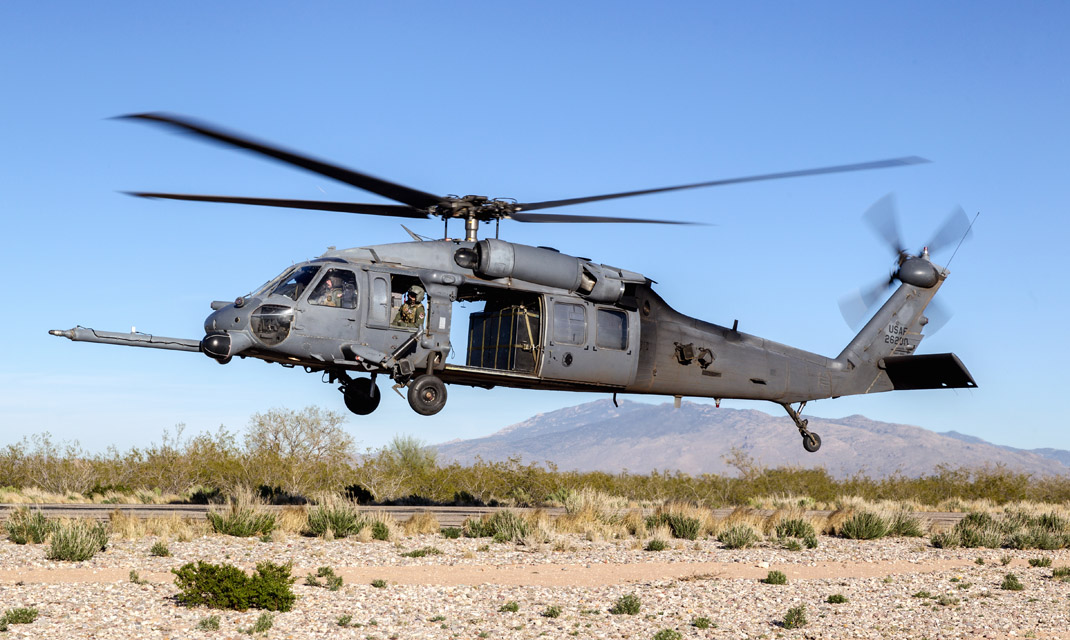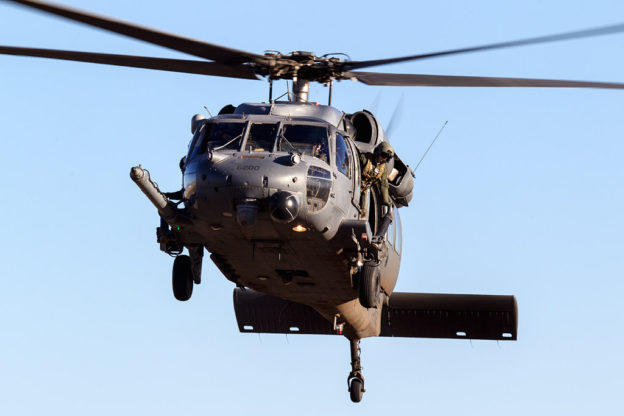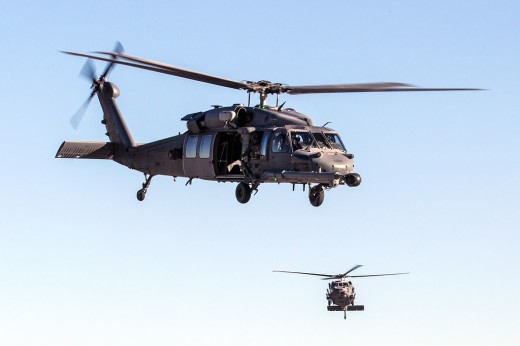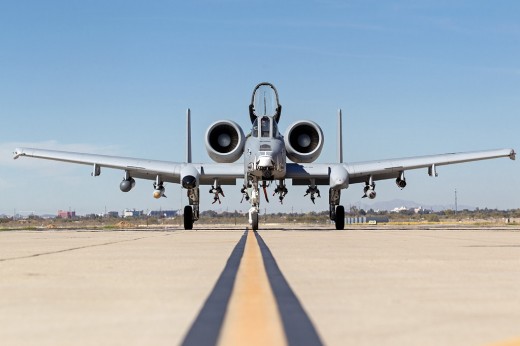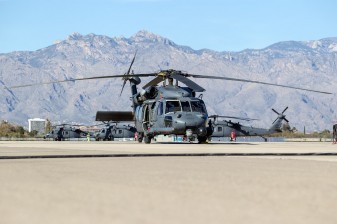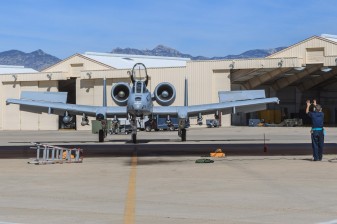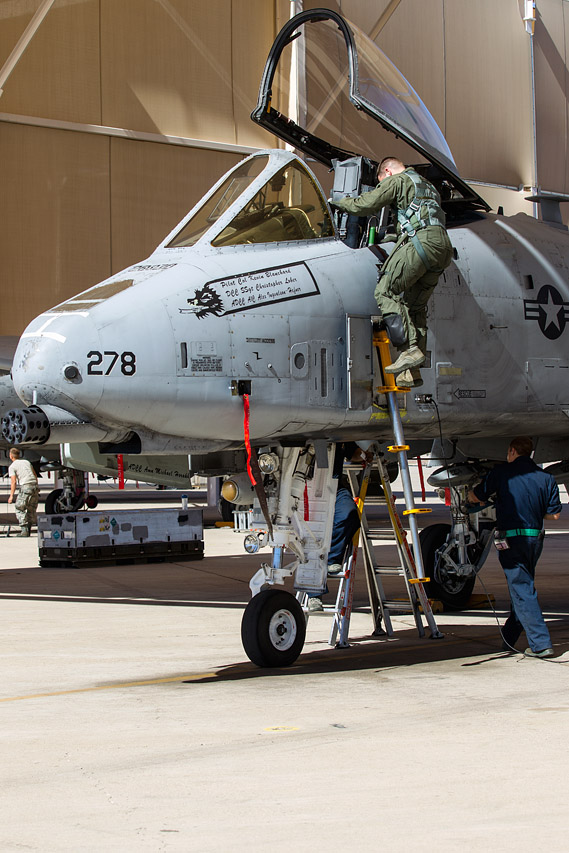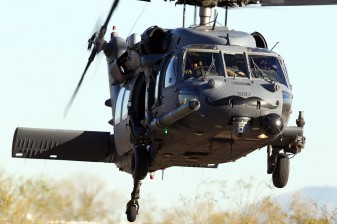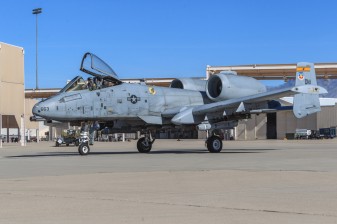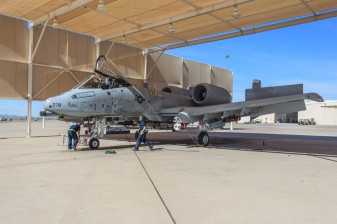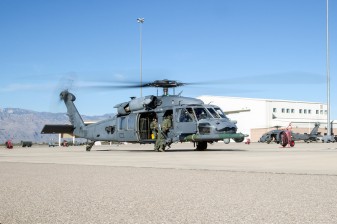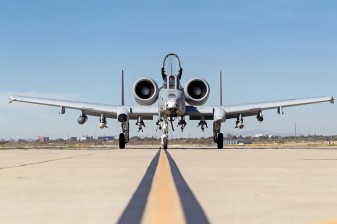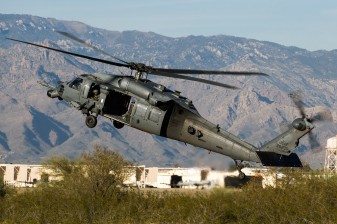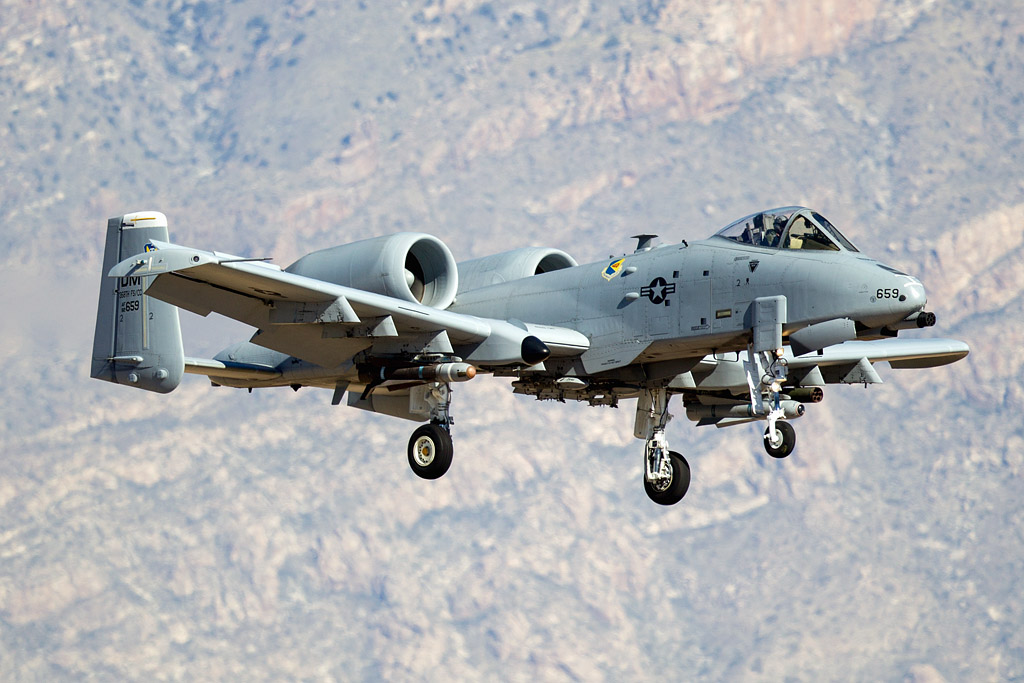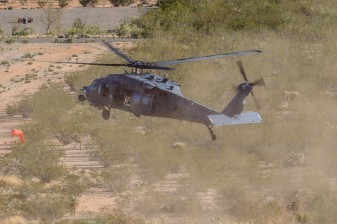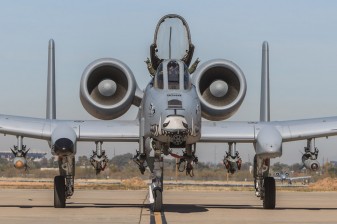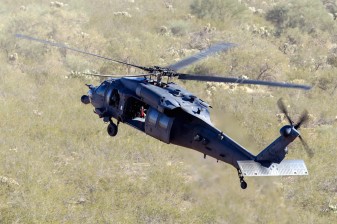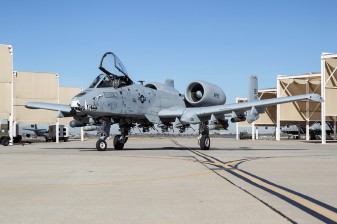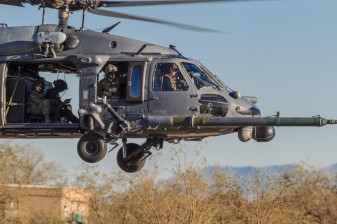Who is going to rescue you, if you have to bail out of your plane far behind enemy lines?
CSAR is not a task for the faint hearted, they go behind enemy lines to rescue the survivors.
|
The Combat Search And Rescue (CSAR) mission, whilst being one of the most dangerous, is also one of the most important as it helps to provide the pilots who fly into combat zones with the assurance that if things go wrong, a group of pilots who are specially
trained and motivated will come and get them out safely.
FLYMAG went to Davis-Monthan Air Force Base in Tucson, Arizona to learn more about the CSAR mission.
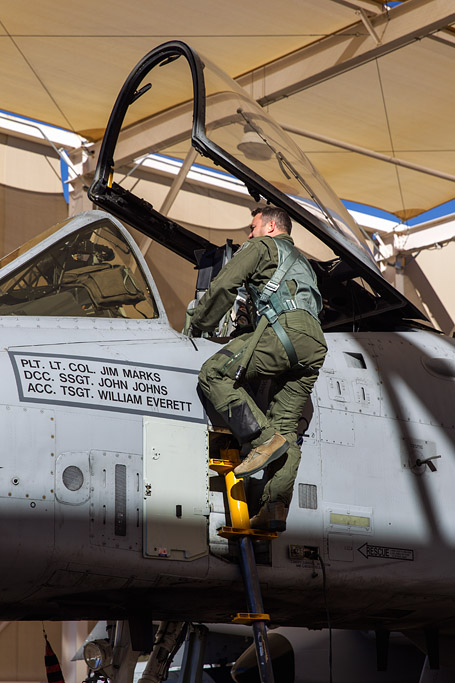
The Hog driver has started to climb aboard his A-10C, while the ground crew
preparing the “Tank killer”.
|
“The Combat Search And Rescue (CSAR) mission, whilst being one of the most dangerous, is also one of the most important.”
The first airfield in Tucson was built back in 1919, but the rapid development in aviation meant that in 1927 it was moved to its current location. The airport was named Davis-Monthan after two pilots from Tucson who died in two separate aircraft accidents
in the early 1920s.
The military presence began on October 6 1927, when Sgt. Simpson moved in with his fuel sales and workshop space. The first military customer was Jimmy Doolittle on 9 October 1927, and as is well known, he went on to win the Medal
of Honor for his attack on Tokyo in 1942. The joint civilian and military operations ran until the early 1940s, when military needs resulted in a relocation of the civilian activities at the site.
Today, the base is home to a variety of units. During the Feid magazine visit in February 2014, the following units were noted amonst others:
355th Fighter Wing:
- 354th Fighter Squadron (A-10C) – Bulldogs
- 357th Fighter Squadron (A-10C) – Dragons
- 358th Fighter Squadron(A-10C) – Lobos (shut down at the end of February 2014)
West Coast A-10 Demo Team 563rd Rescue Group:
- 48th Rescue Squadron (Pararescue)
- 55th Rescue Squadron (HH-60G Pavehawk)
- 79th Rescue Squadron (C-130J)
55th Electronic Combat Group:
- 41st Electronic Combat Squadron (EC-130H) – Scorpions
- 42nd Electronic Combat Squadron (EC-130H) – Raptors
- 43rd Electronic Combat Squadron (EC-130H) – Bats
943rd Rescue Group
- 305th Rescue Squadron (HH-60G)
Due to the recent closure of A-10 Thunderbolt II units around the world, there are currently some A-10s at Davis-Monthan AFB which do not have tail code “DM”. This includes flights from Barksdale (BD), Spangdahlem (SP)
and Osan (OS) air force bases.
|
|
In short, CSAR is the rescue of distressed people within a combat zone and this will typically be pilots who are shot down behind enemy lines.
A downed pilot will often be a good “trophy” to capture for the enemy force, which we clearly saw during the first Gulf War in 1991 when Saddam Hussein showed the captured Allied pilots for propaganda purposes.
Therefore, when downed pilots land in areas where locals will not greet them warmly, it is important that the pilot is picked up by friendly forces as rapidly as possible.
|

Meet Pedro! One of the 55th Rescue Squadron HH-60G Pave Hawk helicopters,
has been painted with a fine mustache, and has been named “Pedro”
|
|
“The first example of a CSAR mission took place in 1915 during World War 1. Squadron Leader Bell-Davies from the Royal Naval Air Service No. 3 Squadron landed behind enemy lines in his Nieuport bi-plane
to rescue Flight Sub-Lt. Guilbert Smylie who had just been shot down.”
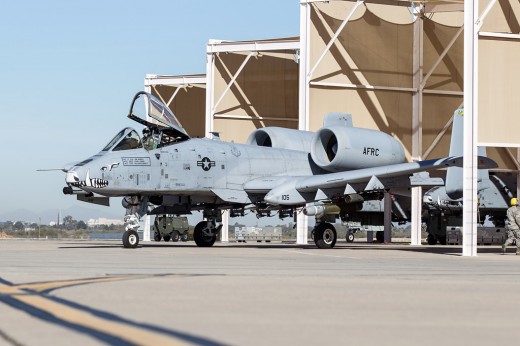
An A-10C Thunderbolt II taxis out from its sunshelter for another mission.
|
As was said before, another important part of the CSAR mission is to give pilots the extra peace of mind that should the worst happen and they end up behind enemy lines, then the group of highly quaified individuals that make up the rescue crews will
come and get them out if it is in any way possible. This makes the pilots feel more comfortable and more willing to spend the extra time to ensure that the bomb hits the target with exceptional accuracy before they head to safety.
The first example of a CSAR mission took place in 1915 during World War 1. Squadron Leader Bell-Davies from the Royal Naval Air Service No. 3 Squadron landed behind enemy lines in his Nieuport bi-plane to rescue Flight Sub-Lt. Guilbert
Smylie who had just been shot down. This showed that it was possible to save the downed pilots.
Over the next decades, during the various wars around the world, techniques and equipment to collect pilots from behind enemy lines slowly developed. During the World War II, many Allied soldiers who were forced to bail out over the
English Channel were rescued by boats or seaplanes. The same was the case in the Pacific, where many American pilots were picked up by ships and aircraft too. Most of these rescues happened without hostile interference and this is
therefore technically not a CSAR mission but “simply” a SAR mission.
Where the CSAR mission really came into its own and where many of the tactics and techniques used today were developed, was during the Vietnam War. During this time, the development of the helicopter reached a point where it was feasible
to use it to search for and collect downed pilots, though in the early years of the war they still lacked sufficient engine power. The best known is probably Sikorsky ‘s HH-3 Jolly Green Giant which was known for the many brave
rescue missions it was used in.
In the years after the Vietnam War, the HH-3 was phased out in favor of the HH-53 and HH-60G Pave Hawk helicopters, both of which were used during the first Gulf War in 1991. The Pave Hawk has also been active in all subsequent conflicts.
At Davis-Monthan AFB, the HH-60G is being flown by the 55th Rescue Squadron.
|
|
The HH-60G Pave Hawk helicopter is a development of Sikorsky’s UH-60 Blackhawk . Its primary task is to provide armed rescue services in hostile areas during both day and night.
Some of the upgrades that change a UH-60 Black Hawk into a HH-60G Pave Hawk are an air refueling probe, extra fuel tanks in the cabin that double the fuel capacity, 12.7mm machine guns on both sides of the cabin, an improved internal
navigation system, satellite communications, secure data communications (Link 16), a night vision compatible cockpit and infra-red camera.
On a CSAR mission, the crew comprises a first pilot, second pilot, a flight engineer (who also mans one machine gun), a gunner and up to three Para Rescue Jumpers also known as PJs. It is the PJ who leaves the helicopter to pick up
the person(s) if they cannot be lifted off by making their own way into the helicopter.
In addition, the helicopter can be outfitted with different equipment that can be used to free trapped persons from crashed aircraft.
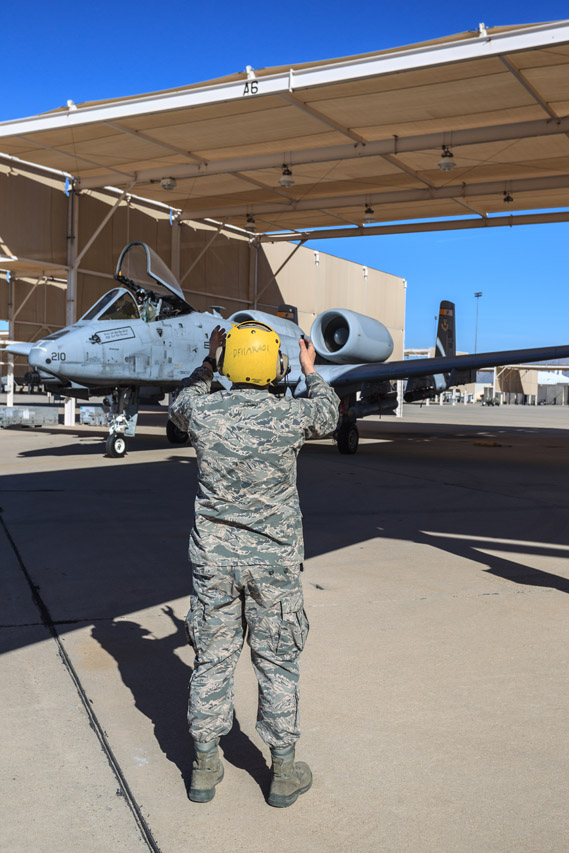
After all checks are complete, then the A-10C Thunderbolt II from the 357th Fighter Squadron is being guided out of the shelter.
|
“Some years ago the USAF began an update program of the A-10 fleet. It comprised of new strengthened wings and an upgrade of the aircraft’s electronics.”
Two HH-60G Pave Hawks fly back to the survivors.
Most people who are interested in military aviation know of the fearsome Fairchild Republic A-10 Thunderbolt II. This plane was specifically designed to provide air support for ground troops and literally built around the amazing General Electric GAU-8
Avenger seven barrelled 30mm Gatling gun. In addition, the plane was designed to operate in areas where it would come under heavy enemy fire.
Hence, it was heavily armoured, all important parts have backup systems including in some cases triplicate sytems. For example, two hydraulic systems are used to operate the control surfaces and these run in different parts of
the plane in order to reduce the risk of both systems being hit simultaneously.
However, should this happen, the aircraft has an emergency system where it can be flown with traditional cabling. This older system is designed to give the pilot enough control of the aircraft to reach to a relatively safe place
where he can then elect to land or eject in a safer manner.
Some years ago the USAF began an update program of the A-10 fleet. It comprised of new strengthened wings and an upgrade of the aircraft’s electronics. This update, known as A-10C gave the aircraft the ability to use new
“smart bombs” such as the GPS guided JDAM.
In addition, the aircraft can now utilise modern targeting facilities, for example the Sniper pod, which enhance the flight options to search for and select targets on the ground. The update has also brought the plane from the
analog into the digital era and has given the A-10 modern data links and secure satellite communications so that the pilot can now exchange vast amounts of information with other aircraft in the area.
|
|
|
During FLYMAG magazine’s visit to Davis-Monthan AFB, we visited the 357th Fighter Squadron which is responsible for training new A-10 pilots and new instructor pilots as well as maintaining instructor status of the current pilots on strength.
The unit was set up in late 1942 at the Orlando Army Air Base in Florida and was first equipped with the Republic P-47 Thunderbolt fighter-bomber. The unit flew air support missions over Europe during World War II and over the years
has flown P-47 Thunderbolt, P-51 Mustang , F-86 Sabre, F-105 Thunderchief, F-4 Phantom II, A-7 Corsair and is now back in the new version of Thunderbolt, namely the A-10C Thunderbolt II. The A-10 is not the first type used by the unit
to train new pilots as they also flew A-7 Corsairs in this role.
The squadron has some of the most experienced and talented A-10 pilots and in 2012 was the overall winner of the Hawgsmoke competition, a competition for A-10 units which is held every two years. The squadrons compete in different
kinds of bombing techniques and of course firing at targets with the 30mm cannon.
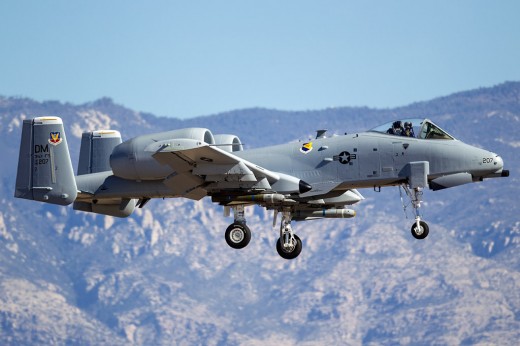
The high mountains which are well outside the city of Tucson, is creating a dramatic backdrop to the A-10 which is coming in for a landing at Davis-Monthan AFB.
|
“The unit’s motto sums up their mission very well: These Things We Do That Others May Live.”
55th Rescue Squadron was established on 14 November 1952 at Thule AFB in Greenland and it stayed here until 18 June 1960 when the unit was deactivated. Thereafter followed a series of activations and deactivations on airfields around America until finally,
on 22 January 2003, the unit was made resident at Davis-Monthan AFB where it has remained to this day.
The unit’s primary mission is CSAR and it has performed this task in a variety of conflicts around the world including the Panama crisis, the first Gulf war and the air war over Kosovo. The unit also performs other tasks
including flights to supply disaster areas, anti-drug operations and civilian SAR missions.
Their training in CSAR missions makes them extremely proficient at performing civil SAR missions. As an example, they managed to locate a missing person in just thirteen minutes in an already explored area after civilian authorities
had been searching for over a week.
The main reason for this efficiency is their in-depth knowledge of flying in pre defined scanning patterns, and the crew’s ability to spot downed people on the ground.
To perform CSAR tasks, the helicopter of choice is the HH-60G Pave Hawk which as described earlier, is a special version of the UH-60 Black Hawk helicopter. The unit’s motto sums up their mission very well: “These Things We Do That Others May Live”.
|
|
|
A CSAR rescue is one of the most complex mission types that exist. Partly because it typically involves many different aircraft and helicopter types, all of which perform various important tasks . Another reason is that missions are usually planned in
a short period of time to be able to save the downed pilot before capture and that there may not be much data about enemy strength in the rescue area.
A CSAR mission is headed by one of the participating pilots, given the call sign “Sandy 1” – typically an A-10 pilot. It takes years of experience and training to be qualified to fly as “Sandy 1” and
lead CSAR missions. A “Sandy 1” pilot must have a thorough knowledge of the strengths and weaknesses of all the other aircraft involved in the rescue operation so that he knows when and how he can best use them to get the
mission completed as effectively as possible.
Because of the mission nature, where you never know where a pilot must be retrieved from and under what circumstances, it is a mission type that A-10 pilots train for a lot so that they can build up so much experience as possible.
They must be able to find fast creative solutions when they are in unfamiliar situations and as such a “Sandy” pilot typically flies ten CSAR training missions per year. This may not sound like much, but to make a CSAR
training mission as realistic as possilbe requires coordination with flights from many other squadrons. In addition, training between the A-10 pilots at Davis-Monthan AFB and the HH- 60G helicopters happens on a weekly basis. There
will also be exercises dedicated to the CSAR mission such as Angel Thunder held every year at Davis-Monthan AFB .

While the pilot slowly brings down the helicopter, the shooter is keeping an eye on the height out of the window. At the same time he also checks that the tail rotor is clear of
any obstacles.
|
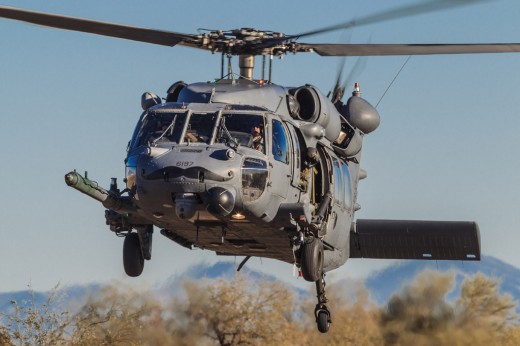
While the pilot slowly brings down the helicopter, the shooter is keeping an eye on the height out of the window.
A CSAR mission team typically consists of two HH-60G Pave Hawk helicopters, four A-10C Thunderbolt II aircraft, an airborne command centre, an aerial tanker and other fighters that are available to provide support to the land and/or air assets.
The four A-10 aircraft are typically divided into two pairs; Sandy 1 (mission leader) and Sandy 2 (his wingman), are responsible for supervising and co-ordinating the mission with the airborne command centre. It is also their task
to locate the downed pilot and confirm that this is the correct person.
Which is of course a task an A-10 aircraft is extremely capable of thanks to its low speed and its phenomenal manoeuverability at low altitude. Its heavy armour and extensive armament are also a big help! A typical load-out on a CSAR
mission will be two AGM-65 Maverick missiles, four bombs, rocket pods and a full load of 1,174 shells for 30mm GAU-8 cannon.
After being modernised into the new A-10C model, the Thunderbolt II aircraft has become far more effective in the Sandy role. The digitization of the cockpit and especially the addition of Link 16 data communications has made ??possible
fast and secure sharing of information with other types of aircraft including AWACS and the HH-60G helicopters. All round, this has brought significant progress to the execution of a CSAR mission.
Although there has been no need to perform a CSAR mission for several years, it still remains a high priority and the training continues extensively to ensure that the crews are ready to step in if one day it suddenly becomes real
and they must pick up a pilot from behind enemy lines.
|
|
|
On February 24 the Department of Defense announced plans to phase out the entire A-10 fleet in the near future. What impact it will have on the performance of the CSAR mission is difficult to say. But the fact is that the USAF does not have a plane that
can take over the role of escorting the helicopters into hostile territory, in the same way as an A-10 can.
Planes like the F-16, F-15E and F-35 simply can not fly slowly enough, or safe enough in the low altitude as it takes to escort the HH-60G’s. If the A-10 fleet will be phased out, and what in that case to take over its place
will the near future tell.
FLYMAG magazine would like to thank Staff Sgt. Angela Ruiz, 355th Fighter Wing Public Affairs Office, Commander Lt. Col. Michael Curley, Major Alec Menoni, Major Joel Bernazzani and Major Daniel Haugh from the 357th Fighter Squadron
and Capt. Christopher Karins, Capt. Thomas Steiner and Capt. Brian Dicks from the 55th Rescue Squadron for their great kindness and assistance during FLYMAG’s visit.
|
It is said that A-10 was designed around it’s big gun, and that it has been eye named “The Warthog”.
|
|
